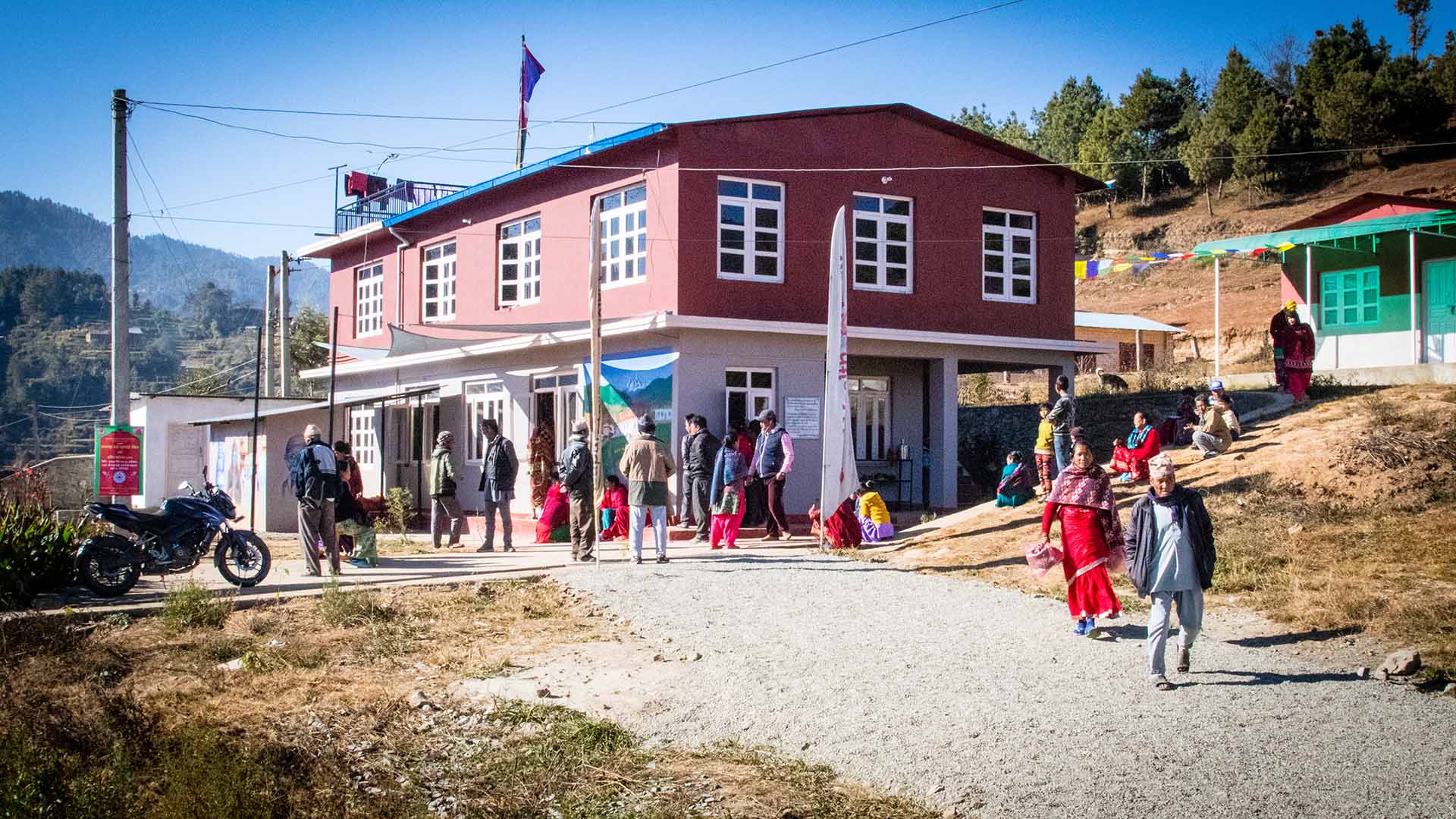News Blog
Latest News From Our Volunteers in Nepal
VOLUNTEER COMMUNITY CARE CLINICS IN NEPAL
Nepal remains one of the poorest countries in the world and has been plagued with political unrest and military conflict for the past decade. In 2015, a pair of major earthquakes devastated this small and fragile country.
Since 2008, the Acupuncture Relief Project has provided over 300,000 treatments to patients living in rural villages outside of Kathmandu Nepal. Our efforts include the treatment of patients living without access to modern medical care as well as people suffering from extreme poverty, substance abuse and social disfranchisement.
Common conditions include musculoskeletal pain, digestive pain, hypertension, diabetes, stroke rehabilitation, uterine prolapse, asthma, and recovery from tuberculosis treatment, typhoid fever, and surgery.
FEATURED CASE STUDIES
Rheumatoid Arthritis +
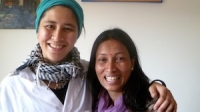
35-year-old female presents with multiple bilateral joint pain beginning 18 months previously and had received a diagnosis of…
Autism Spectrum Disorder +
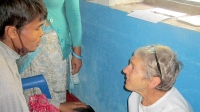
20-year-old male patient presents with decreased mental capacity, which his mother states has been present since birth. He…
Spinal Trauma Sequelae with Osteoarthritis of Right Knee +
60-year-old female presents with spinal trauma sequela consisting of constant mid- to high grade pain and restricted flexion…
Chronic Vomiting +
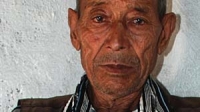
80-year-old male presents with vomiting 20 minutes after each meal for 2 years. At the time of initial…
COMPASSION CONNECT : DOCUMENTARY SERIES
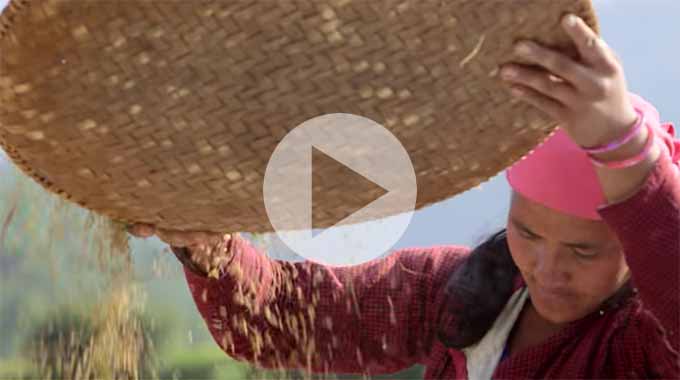
Episode 1
Rural Primary Care
In the aftermath of the 2015 Gorkha Earthquake, this episode explores the challenges of providing basic medical access for people living in rural areas.
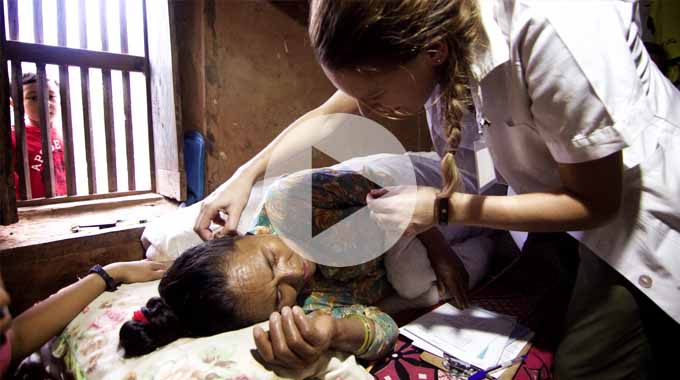
Episode 2
Integrated Medicine
Acupuncture Relief Project tackles complicated medical cases through accurate assessment and the cooperation of both governmental and non-governmental agencies.
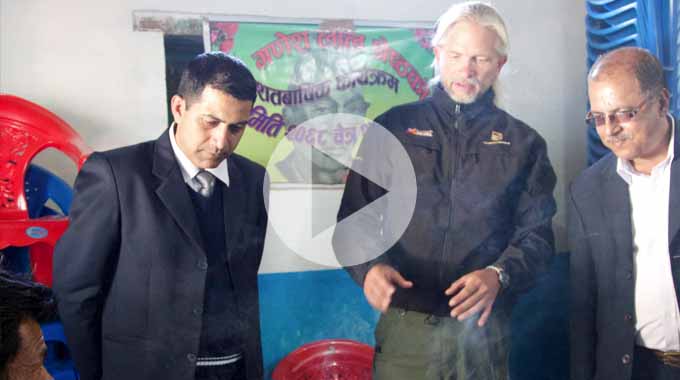
Episode 3
Working With The Government
Cooperation with the local government yields a unique opportunities to establish a new integrated medicine outpost in Bajra Barahi, Makawanpur, Nepal.
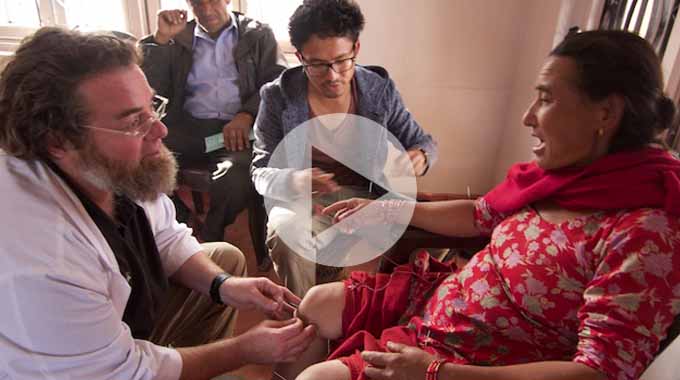
Episode 4
Case Management
Complicated medical cases require extraordinary effort. This episode follows 4-year-old Sushmita in her battle with tuberculosis.
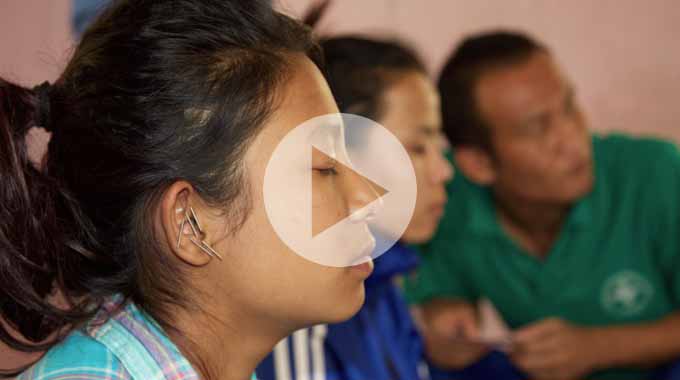
Episode 5
Sober Recovery
Drug and alcohol abuse is a constant issue in both rural and urban areas of Nepal. Local customs and few treatment facilities prove difficult obstacles.
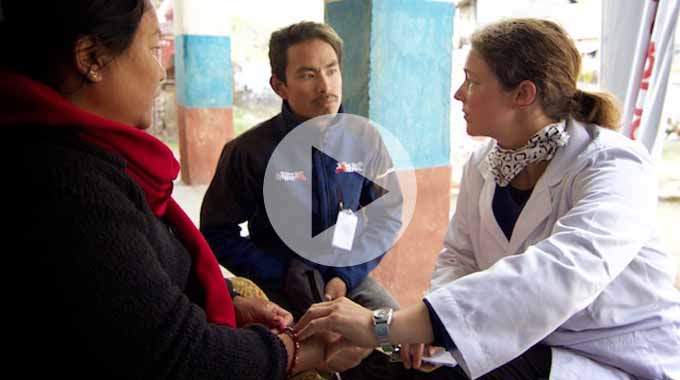
Episode 6
The Interpreters
Interpreters help make a critical connection between patients and practitioners. This episode explores the people that make our medicine possible and what it takes to do the job.
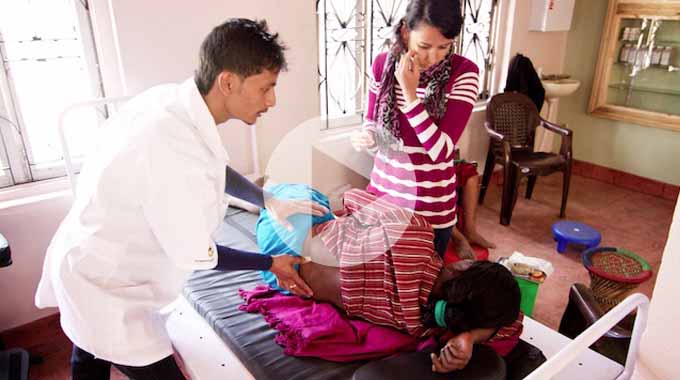
Episode 7
Future Doctors of Nepal
This episode looks at the people and the process of creating a new generation of Nepali rural health providers.
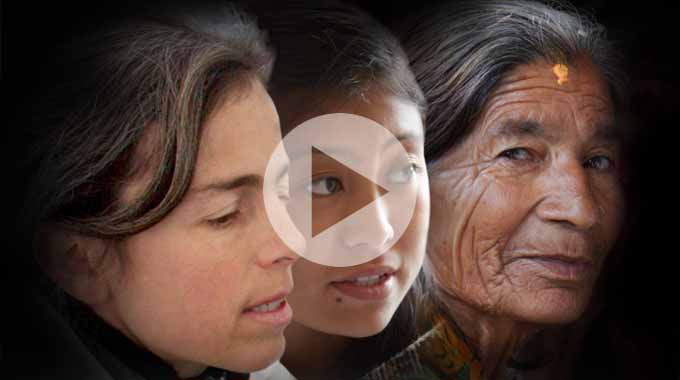
Compassion Connects
2012 Pilot Episode
In this 2011, documentary, Film-maker Tristan Stoch successfully illustrates many of the complexities of providing primary medical care in a third world environment.
From Our Blog
- Details
- By Rachel Pearce
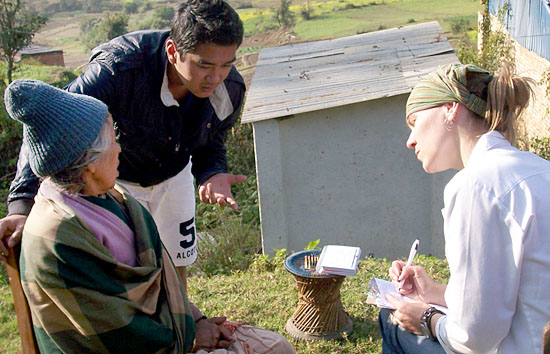
{s5_mp3}http://www.acupuncturereliefproject.org/images/stories/mp3/OMV4.mp3{/s5_mp3}One Minute View: Episode 4
My 33rd birthday was one I never want to forget.
I woke up in the room I was sharing with Katie, covered by my sleeping bag I was using as a blanket. It was the last day of our 7 week volunteer mission in Nepal. The sound of barking dogs, roosters, and chanting monks woke me from my slumber as it had every morning at around 5.45am. It's amazing how such annoyances at first soon become a familiarity you grow to love. I rolled over and awoke again around 6.30am. I lay in my cocoon of warmth excited for the day but not wanting to expose myself to the temperature of our brick and marble room. We had learned early on that if we kept our bedroom door closed at all times it would stay about 10 degrees warmer than the rest of the clinic. “In or out” became a phrase commonly shouted in jest to visitors of our living quarters. The clinic opened at 9am but I planned on getting up early this morning. I wanted to wander around the village while the sun came up. I finally threw my sleeping bag aside while at the same time reaching for my jeans. I quickly slipped them on over the long johns I had been sleeping in. I pulled a fleece over the long sleeve shirt I wore to bed and zipped on my puffy coat. Hat, hand warmers, camera and I was out the door.
I walked down the hallway to the stairs with the sound of the clinic cat meowing from the roof. It was too early to let her in, she would inevitably wake Katie with her never ending cry for attention. An itch Katie could not scratch due to her skin breakouts caused by the feline kind. I continued down the staircase where I reached the clinic waiting room. The space that would be teeming with energy in a few short hours was barren. The marble floor soon to be streaked with dirt and mud of distant places carried in on the feet of our patients, now gleamed from Uma mopping it the evening before. The desk was empty, the interpreters would not arrive to work until 8.45. I slipped off my grandmothers house shoes I brought with me, the distinct sound they made on the marble floor while walking made it easy for Katie and Maura to always know I was coming, put on my outdoor shoes and walked out the door.
As I stepped over the three sleeping dogs on the steps of the clinic I saw the gumpa in the dawn light and realized I had been living next door for seven weeks and had never once taken a walk around it. I stood at the front door for a minute enjoying the sounds of horns, gongs and voices being forced into my eardrums. I began the ceremonial clockwise rotation around the monastery while spinning prayer wheels and greeting monks. "Namaste" (I see God in you).
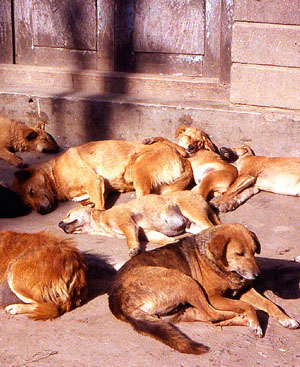 I will forever have the picture in my head of Katie, hands in prayer position, leaning over in respect to people, big smile on her face. She was the best at greeting people. Finishing my circular path I again stood at the front of the gumpa. I walked backwards until I could fit the tiered structure in my camera lens and snapped a picture. I looked down to see my companion for my morning jaunt, Happy. Happy, one of the gumpa dogs loved going on walks. Unfortunately when you walk around the village with a dog mayhem ensues wherever you go. The last time Satyamohan and I went on a walk with Happy a 15 member dog fight broke out. Against my better judgment, not that I had a choice in the matter, Happy joined me for my birthday walk.
I will forever have the picture in my head of Katie, hands in prayer position, leaning over in respect to people, big smile on her face. She was the best at greeting people. Finishing my circular path I again stood at the front of the gumpa. I walked backwards until I could fit the tiered structure in my camera lens and snapped a picture. I looked down to see my companion for my morning jaunt, Happy. Happy, one of the gumpa dogs loved going on walks. Unfortunately when you walk around the village with a dog mayhem ensues wherever you go. The last time Satyamohan and I went on a walk with Happy a 15 member dog fight broke out. Against my better judgment, not that I had a choice in the matter, Happy joined me for my birthday walk.
Out the front gate of the compound that was unlocked hours before to let Buddhists in for there early morning meditation and past Lila's, the Mountain View Restaurant. I thought for a moment about popping in for a hot sill and some milk tea before realizing I had left in such a rush I left my Rupees at home. I continued into Chapagaon along the now familiar road I had traveled so many times by all types of transport, bus, micro, motorcycle, foot. Watching my footing, traffic from all directions, and the distant scenery I continued on. The mountain peaks northwest of the clinic were beginning to turn pink with the new light of the day. I refused to take a picture knowing it wouldn't portray properly what I was seeing or feeling at that moment.
I walked passed the tea shop Katie, Diane, Nicky and I sat and chatted in for hours after clinic one afternoon, passed the store in which Katie bought my birthday present days before but I had yet to receive as she was still fast asleep, and into town. When I reached main street I took a left in the direction of the suspension bridge Satyamohan had taken me to earlier that week.
Being in China for a month, and now Nepal for almost two I have become accustomed to the stares and double takes I get while walking down the street. It's not often a white female with long dirty blonde hair towering over most of the men comes walking through town in the country side of Nepal. I can't blame them and I take no offense. Catching a glimpse of myself recently I was startled to see my own white skin after being surrounded by so many dark skinned beauties for so long. Shop owners were busy sweeping and watering the street in front of there store, setting up merchandise for that days sales, while school children of all ages dressed in there identical uniforms laughed and chatted with each other on their way to school. I adore the girls with their matching ribbons in each braid or piggy tail and the boys walking together with arms around each others shoulders.
 Nearing the end of main street I turned left. Now strolling by homes, people were going about their morning routines. Many where carrying offerings of flowers to their local shrine, women and girls combing each others hair, men shaving with hand held mirrors, bathes being taken from cold water spigots, and babies hanging from there mothers backs looking through their thick black eyeliner taking it all in. I knew my way through the nameless streets and alleyways from the many walks I had taken with Satyamohan after the clinic closed. Our sunset walks were something I always looked forward to, leaving the clinic just as the clouds overhead were turning pink and returning home in the dark an hour or so later. But today it was the start of the day, my day, and I was ready to enjoy every moment of it.
Nearing the end of main street I turned left. Now strolling by homes, people were going about their morning routines. Many where carrying offerings of flowers to their local shrine, women and girls combing each others hair, men shaving with hand held mirrors, bathes being taken from cold water spigots, and babies hanging from there mothers backs looking through their thick black eyeliner taking it all in. I knew my way through the nameless streets and alleyways from the many walks I had taken with Satyamohan after the clinic closed. Our sunset walks were something I always looked forward to, leaving the clinic just as the clouds overhead were turning pink and returning home in the dark an hour or so later. But today it was the start of the day, my day, and I was ready to enjoy every moment of it.
Animals roamed the streets and paths I walked along. Ducks, chickens and roosters wandered at free will eating from garbage piles and occasionally getting underfoot. Cows and goats tethered to their owners house watched me walk by while slowly chewing their breakfast. I came upon a litter of puppies reminding me of the three born at the gumpa only days before. Nearing home I looked up to see the sun just about to peek over the hills.
I began walking faster, I wanted to take a picture of the gumpa with the sunrise behind it from the roof of our clinic. As I rushed through the gate I heard a voice traveling in my direction. I looked over to see Ty, one of the monks, shouting happy birthday to me. At that moment I knew it was going to be a day I would never forget. –Rachel Pearce
Admin note: Acupuncture Relief Project sincerely thanks Rachel Pearce for her dedication, compassion and hard work in Nepal. We also wish her a very Happy Birthday.
- Details
- By Andrew Schlabach
As a person that can't quite get enough of Nepal I sometimes find it hard to convey to my friends, patients and colleagues just what keeps me going back. It is a place so filled with contradiction and wonder that it just gets into your blood. Recently I read the latest book by Jeff Greenwald called Snake Lake. Jeff writes that when he first visited the Hindu kingdom in 1979 he knew that he had arrived "home". I think the Jeff and I were probably meant to be neighbors because Kathmandu also feels like home to me. Even with all its pollution, constant political upheaval and abundant poverty, Nepal never ceases to captivate my sense of brotherhood in the world.
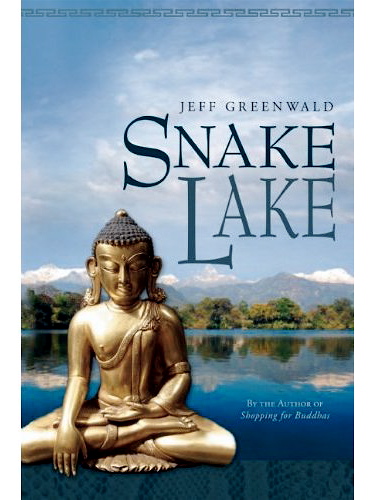 Snake Lake is an amazing first hand account of Nepal's political drama and corruption. More than that, it is a humorous memoir with a delightful introspective look at why this exotic place is so beautifully captivating. I know it is a place that always calling for me to "come home."
Snake Lake is an amazing first hand account of Nepal's political drama and corruption. More than that, it is a humorous memoir with a delightful introspective look at why this exotic place is so beautifully captivating. I know it is a place that always calling for me to "come home."
I contacted Jeff and he gave me permission to share this short article on our blog. I hope you enjoy it. - Andrew
Admin note: Thanks to Jeff Greenwald for this contribution. You can find his book Snake Lake at Amazon.com
The Facts of Kathmandu
© 2011 by Jeff Greenwald
I first arrived in Nepal as a tourist, in July of 1979. The giddy entry in my journal that day reads, “Welcome home.” Without understanding why, I’d found the place that would be my spiritual refuge and writer’s retreat for the next 30 years.
I stayed in Nepal for five months that year, and returned in 1983 on a year-long journalism fellowship. I’ve come back nearly every year since. Shopping for Buddhas, written in 1988, focused on my search for the “perfect” Buddha statue—but that theme served as a foil for exploring Nepal’s awkward entry in the modern age. My new book, Snake Lake, is set in Kathmandu in the Spring of 1990, during the often violent pro-democracy uprising. The revolution tipped the late King Birendra off his divine throne, and into a constitutional monarchy. That was when Nepal’s real struggle began.
The changes I’ve seen during the past 20 years have touched every facet of life in the country. From the Royal Massacre to the tragic civil war; from the runaway development of the Valley to the emergence of China as an eager and bossy ally. Kathmandu is no longer the place of innocence it seemed to be in the 1980s, when I shopped for Buddha statues in uncrowded chowks, or strolled down narrow lanes as sacred cows eyed me warily from doorways. When the monarchy was abolished in 2008, and a Maoist government took over, even the country’s exotic tag line—“The World’s Only Hindu Kingdom”—became obsolete.
- Details
- By Diane Wintzer
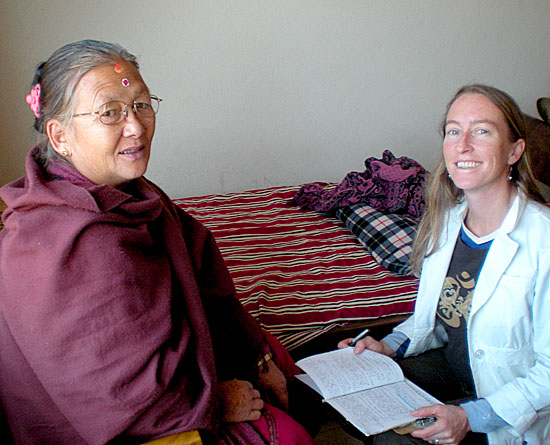
{s5_mp3}http://www.acupuncturereliefproject.org/images/stories/mp3/OMV2.mp3{/s5_mp3}One Minute View: Episode 2
These first few weeks have gone fast! It's amazing how quickly all the newness of such an experience is transformed into a mostly reliable routine. That routine serves as a safety net for all the unknowns in a day. A common theme that has come up for us is the idea of "what gets lost in translation anyway?". This idea is multi-dimensional and in it is reflected a person's story, a person's belief system, how a person understands something, and how well our language conveys across culture the story we are telling. Our interpreters are trained very well for their jobs - they are excellent! They make the exchange almost seamless! They not only interpret what we say and what our patients say, but they also have to interpret the context and the emotion of what is said.
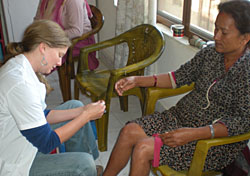 It's
similar to a game of telephone but rather than the story being changed
through a long line of people, it is more a matter of how our stories
get filtered through our different ways of experiencing the world.
Despite our mostly clear communication, we realize that some concepts
don't exist in one culture exactly the same as it does in another. I
recently learned that there really is not a word in Nepali for
"throbbing", as in a throbbing headache, but rather the interpreter
explains that the patient says, "the headache feels like it does when
you have your finger on someone's pulse." It's a beautiful moment when
it comes together like that!
It's
similar to a game of telephone but rather than the story being changed
through a long line of people, it is more a matter of how our stories
get filtered through our different ways of experiencing the world.
Despite our mostly clear communication, we realize that some concepts
don't exist in one culture exactly the same as it does in another. I
recently learned that there really is not a word in Nepali for
"throbbing", as in a throbbing headache, but rather the interpreter
explains that the patient says, "the headache feels like it does when
you have your finger on someone's pulse." It's a beautiful moment when
it comes together like that!
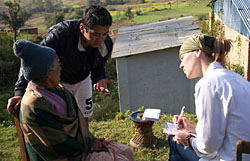 I sit back at the end of a day of
treating patients and observing the other practitioners treating, and
settle on this idea: what gets lost in translation is made up for by
watching someone's facial expression, by observing a persons hands when
they talk, by watching their chest rise and fall to understand their
breathing, by noticing how someone gets in or out of their chair, by
paying attention to the tone of their voice behind the story, by
palpating the spots that hurt, and by looking in their eyes clearly for
the moment when the ritualistic "namaste" is exchanged in their coming
and going. Sometimes the story matches what we expect to hear - "I have
diabetes, I have knee pain, or I have burning and tingling in my feet"
I sit back at the end of a day of
treating patients and observing the other practitioners treating, and
settle on this idea: what gets lost in translation is made up for by
watching someone's facial expression, by observing a persons hands when
they talk, by watching their chest rise and fall to understand their
breathing, by noticing how someone gets in or out of their chair, by
paying attention to the tone of their voice behind the story, by
palpating the spots that hurt, and by looking in their eyes clearly for
the moment when the ritualistic "namaste" is exchanged in their coming
and going. Sometimes the story matches what we expect to hear - "I have
diabetes, I have knee pain, or I have burning and tingling in my feet"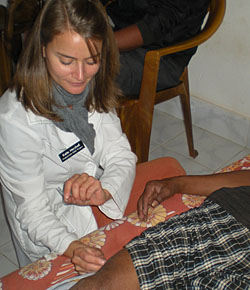 and other times
the story makes us see something differently as a person shares that
they believe they might have a curse on them, or they had an organ
removed and then put back in the right place, or sometimes a nerve grows
out of the corner of their toe and when it does it hurts and they cut
it off. As a practitioner, sometimes I rely on the story I'm hearing
while other times I may follow a feeling or intuition of the experience
that seems to resonate in their story. In the case of the mystery toe
pain... Maybe they're telling me they have an ingrown toenail that feels
incredibly nervy and painful or maybe they are experiencing something
that is completely lost in translation. As I work though the many puzzles
and mysteries I come to this essential realization. The realization
that if we learn to listen carefully and do our best to hear not only
the story they share but also the story they embody, the treatment we
offer can speak better to the overall CARE of that individual patient.
The more we improve in this skill, the more we minimize all that gets
lost along the way. The story that each of us shares, through the bridge
of an interpreter or through the descriptive sounds and the hand
gestures, are the stories that link us together. It is the sharing of
our stories that creates deeper understanding and compassion between us
and opens our eyes to much more than what simple words can convey. – Diane Wintzer
and other times
the story makes us see something differently as a person shares that
they believe they might have a curse on them, or they had an organ
removed and then put back in the right place, or sometimes a nerve grows
out of the corner of their toe and when it does it hurts and they cut
it off. As a practitioner, sometimes I rely on the story I'm hearing
while other times I may follow a feeling or intuition of the experience
that seems to resonate in their story. In the case of the mystery toe
pain... Maybe they're telling me they have an ingrown toenail that feels
incredibly nervy and painful or maybe they are experiencing something
that is completely lost in translation. As I work though the many puzzles
and mysteries I come to this essential realization. The realization
that if we learn to listen carefully and do our best to hear not only
the story they share but also the story they embody, the treatment we
offer can speak better to the overall CARE of that individual patient.
The more we improve in this skill, the more we minimize all that gets
lost along the way. The story that each of us shares, through the bridge
of an interpreter or through the descriptive sounds and the hand
gestures, are the stories that link us together. It is the sharing of
our stories that creates deeper understanding and compassion between us
and opens our eyes to much more than what simple words can convey. – Diane Wintzer
Admin note: This was Diane Wintzer's second trip to Nepal with the Acupuncture Relief Project. This fall she served as our project lead and course instructor. When she is not in Nepal, Diane practices at Fearn Natural Health Clinic in Camas Washington. Thanks Diane for your continued service.
Our Mission
Acupuncture Relief Project, Inc. is a volunteer-based, 501(c)3 non-profit organization (Tax ID: 26-3335265). Our mission is to provide free medical support to those affected by poverty, conflict or disaster while offering an educationally meaningful experience to influence the professional development and personal growth of compassionate medical practitioners.
